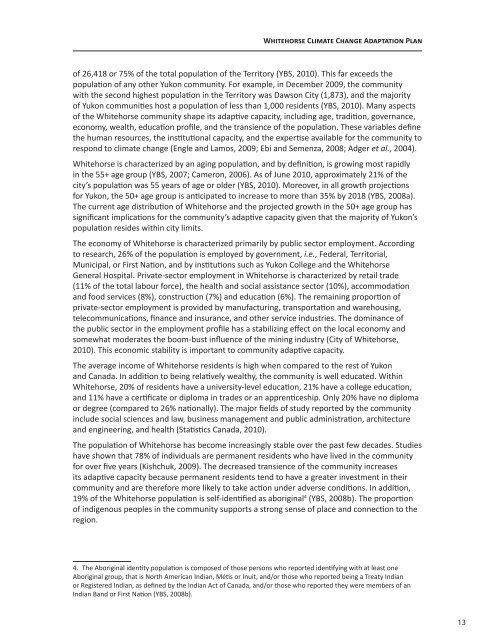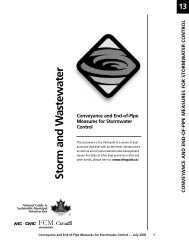Whitehorse Climate Change Adaptation Plan - Yukon College
Whitehorse Climate Change Adaptation Plan - Yukon College
Whitehorse Climate Change Adaptation Plan - Yukon College
You also want an ePaper? Increase the reach of your titles
YUMPU automatically turns print PDFs into web optimized ePapers that Google loves.
<strong>Whitehorse</strong> <strong>Climate</strong> <strong>Change</strong> <strong>Adaptation</strong> <strong>Plan</strong><br />
of 26,418 or 75% of the total population of the Territory (YBS, 2010). This far exceeds the<br />
population of any other <strong>Yukon</strong> community. For example, in December 2009, the community<br />
with the second highest population in the Territory was Dawson City (1,873), and the majority<br />
of <strong>Yukon</strong> communities host a population of less than 1,000 residents (YBS, 2010). Many aspects<br />
of the <strong>Whitehorse</strong> community shape its adaptive capacity, including age, tradition, governance,<br />
economy, wealth, education profile, and the transience of the population. These variables define<br />
the human resources, the institutional capacity, and the expertise available for the community to<br />
respond to climate change (Engle and Lamos, 2009; Ebi and Semenza, 2008; Adger et al., 2004).<br />
<strong>Whitehorse</strong> is characterized by an aging population, and by definition, is growing most rapidly<br />
in the 55+ age group (YBS, 2007; Cameron, 2006). As of June 2010, approximately 21% of the<br />
city’s population was 55 years of age or older (YBS, 2010). Moreover, in all growth projections<br />
for <strong>Yukon</strong>, the 50+ age group is anticipated to increase to more than 35% by 2018 (YBS, 2008a).<br />
The current age distribution of <strong>Whitehorse</strong> and the projected growth in the 50+ age group has<br />
significant implications for the community’s adaptive capacity given that the majority of <strong>Yukon</strong>’s<br />
population resides within city limits.<br />
The economy of <strong>Whitehorse</strong> is characterized primarily by public sector employment. According<br />
to research, 26% of the population is employed by government, i.e., Federal, Territorial,<br />
Municipal, or First Nation, and by institutions such as <strong>Yukon</strong> <strong>College</strong> and the <strong>Whitehorse</strong><br />
General Hospital. Private-sector employment in <strong>Whitehorse</strong> is characterized by retail trade<br />
(11% of the total labour force), the health and social assistance sector (10%), accommodation<br />
and food services (8%), construction (7%) and education (6%). The remaining proportion of<br />
private-sector employment is provided by manufacturing, transportation and warehousing,<br />
telecommunications, finance and insurance, and other service industries. The dominance of<br />
the public sector in the employment profile has a stabilizing effect on the local economy and<br />
somewhat moderates the boom-bust influence of the mining industry (City of <strong>Whitehorse</strong>,<br />
2010). This economic stability is important to community adaptive capacity.<br />
The average income of <strong>Whitehorse</strong> residents is high when compared to the rest of <strong>Yukon</strong><br />
and Canada. In addition to being relatively wealthy, the community is well educated. Within<br />
<strong>Whitehorse</strong>, 20% of residents have a university-level education, 21% have a college education,<br />
and 11% have a certificate or diploma in trades or an apprenticeship. Only 20% have no diploma<br />
or degree (compared to 26% nationally). The major fields of study reported by the community<br />
include social sciences and law, business management and public administration, architecture<br />
and engineering, and health (Statistics Canada, 2010).<br />
The population of <strong>Whitehorse</strong> has become increasingly stable over the past few decades. Studies<br />
have shown that 78% of individuals are permanent residents who have lived in the community<br />
for over five years (Kishchuk, 2009). The decreased transience of the community increases<br />
its adaptive capacity because permanent residents tend to have a greater investment in their<br />
community and are therefore more likely to take action under adverse conditions. In addition,<br />
19% of the <strong>Whitehorse</strong> population is self-identified as aboriginal4 (YBS, 2008b). The proportion<br />
of indigenous peoples in the community supports a strong sense of place and connection to the<br />
region.<br />
4. The Aboriginal identity population is composed of those persons who reported identifying with at least one<br />
Aboriginal group, that is North American Indian, Métis or Inuit, and/or those who reported being a Treaty Indian<br />
or Registered Indian, as defined by the Indian Act of Canada, and/or those who reported they were members of an<br />
Indian Band or First Nation (YBS, 2008b).<br />
13

















